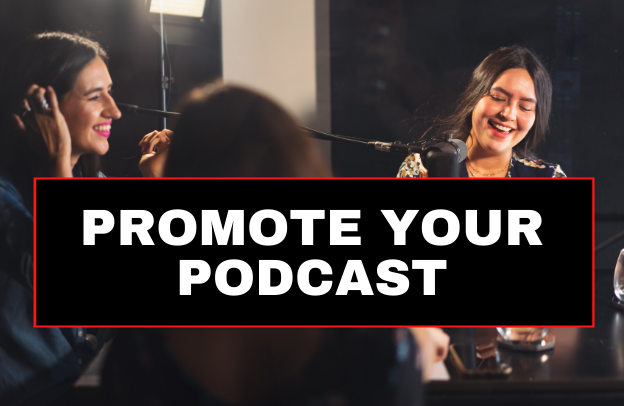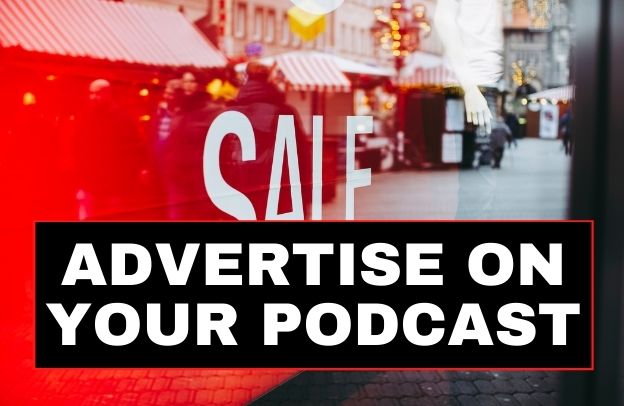10 Easy Ways To Promote Your Podcast As A Beginner

You have come to the right place if you want to understand how to market a podcast and how a good podcast promotion strategy may help you grow your listenership. Podcast listeners are very passionate and can often spark thoughts and conversation around topics that interest them. Cultivating a community of listeners that share your point of view is a great way to improve your brand’s reach.
Download the first chapter of The Storytelling Series: Beginners’ Guide for Small Businesses & Content Creators by Obehi Ewanfoh.
Two Important Components of Podcasting
Let’s take a step back and analyze the basis of our podcast before diving into our easy ways to promote a podcast. We will see these two most important aspects of podcasting: high-quality content and sufficient time. We need to be sure that what we are working on is worth promoting, and that our expectations for success are reasonable.
Create High-Quality Content
Providing value is the best long-term tool for promoting a podcast. Shortcuts and gimmicks may help in the short term, but they won’t last. Rather than following the next marketing fad, concentrate on building value through solid relationships and high-quality content. That is where you will get a good return on your investment.
Easy Ways to Follow in Your Podcast Promotion
Are you still reading?
I’m sure you are curious about the simplest ways to market a podcast at this point. So, without further ado, here are our ten simple strategies to promote your podcast, starting today:
Make 3 episodes available on the day of launching
On the day of the launch, at least three episodes should be available.
Make at least three episodes prior to launching your podcast. If you don’t have several episodes for new listeners to sample, there’s a significant possibility they won’t become engrossed in your show and will eventually forget about it.
Decide on an email strategy that works for you
Whenever a new episode is released, send an email to your mailing list to let them know. Whether you have a large or small mailing list, email is among the most effective ways to get people to listen to your episode.
Promoting your podcast through email can be an effective way to reach your audience and keep them engaged with your content. Here are some tips on how to create an email strategy that works for you:
- Build your email list: The first step in any email strategy is to build your list of subscribers. Encourage your podcast listeners to sign up for your email newsletter by including a call-to-action at the end of each episode or on your website. You can also offer incentives like exclusive content or discounts for signing up.
- Segment your list: Once you have a list of subscribers, segment it based on their interests and behaviors. This will allow you to send targeted emails that are more relevant and engaging to your audience.
- Plan your email content: Create a content calendar for your email campaigns, including any upcoming episodes, events, or promotions. This will help you stay organized and ensure that you’re sending regular, consistent emails to your subscribers.
- Personalize your emails: Use your subscribers’ names and other personal information to make your emails more personal and engaging. You can also segment your list based on demographics or interests to further personalize your content.
- Optimize your subject lines: Your subject line is the first thing your subscribers will see, so make sure it’s compelling and attention-grabbing. Use action-oriented language and avoid spammy or clickbait-style subject lines.
- Keep it concise: Keep your emails concise and to-the-point. Use short paragraphs and bullet points to make your content easy to skim and understand.
- Include a call-to-action: Include a clear call-to-action in each email, whether it’s to listen to your latest episode, leave a review, or sign up for a promotion. Make it easy for your subscribers to take the desired action by including links or buttons.
- Test and optimize: Test different email strategies and tactics to see what works best for your audience. Use metrics like open rates, click-through rates, and conversion rates to measure the success of your campaigns and make adjustments as needed.
By following these tips, you can create an effective email strategy that promotes your podcast and keeps your audience engaged with your content.
Make audio clips to present the highlights of each episode
Make shareable “audiograms” out of fragments of your podcast talk. An “audiogram” is essentially a graphic that has been turned into a video ideal for social networking. When compared to a static image, audiograms produced 5x the traffic, according to one study.
Creating audio clips to highlight the best moments of your podcast episodes is a great way to promote your show and attract new listeners. Here are some steps you can follow to create effective audio clips:
- Choose your highlights: Listen back to your podcast episodes and identify the most interesting, insightful, or entertaining moments. These will be the highlights you want to showcase in your audio clips.
- Determine the length: Decide on the length of your audio clips based on the platform you’ll be sharing them on. For example, Instagram limits clips to 60 seconds, while Twitter allows up to 2 minutes and 20 seconds.
- Edit the audio: Use audio editing software to trim and enhance your audio clips. Focus on the most compelling parts of the conversation and make sure the audio is clear and easy to understand.
- Add context: Include a brief introduction to provide context for your audio clip. This could be a summary of the episode topic or a teaser for what’s to come.
- Create a visual: Use a tool like Canva or Adobe Spark to create a visual to accompany your audio clip. This could be a still image or a short video that includes the audio clip’s caption or text overlay.
- Share on social media: Share your audio clips on your social media accounts, including Instagram, Twitter, and Facebook. Use relevant hashtags and tags to reach a wider audience and encourage engagement.
- Include in your email newsletter: Include links to your audio clips in your email newsletter to promote your podcast to your subscribers. Encourage them to share the clips with their own networks to help spread the word about your show.
By creating and sharing audio clips, you can showcase the best moments of your podcast episodes and attract new listeners to your show. Remember to be creative and experiment with different formats and platforms to see what works best for your audience.
Use your social media accounts for promotion
Sharing your shows on Twitter, LinkedIn, Instagram, Facebook, Pinterest, and YouTube is a no-brainer. Slice up your episode to find the most intriguing statements and information to share on the social media channels where you are most active.
Social media is a powerful tool for promoting your podcast and reaching a wider audience. Here are some tips on how to use social media to promote your podcast effectively:
- Choose your platforms: Identify which social media platforms your target audience uses the most and focus your efforts on those platforms. Popular options include Twitter, Facebook, Instagram, and LinkedIn.
- Create a social media schedule: Plan out a schedule for promoting your podcast on social media, including when and how often you’ll post. Consistency is key, so aim to post at least once a week.
- Share episode highlights: Create short audio or video clips to highlight the best moments of your podcast episodes. Share these clips on your social media accounts with a caption that encourages followers to listen to the full episode.
- Use eye-catching visuals: Use eye-catching visuals, such as custom graphics or episode artwork, to promote your podcast on social media. Make sure your visuals are high-quality and consistent with your brand.
- Engage with your audience: Engage with your followers by responding to comments and messages. Ask for feedback and suggestions for future episodes to encourage engagement.
- Collaborate with other podcasters: Collaborate with other podcasters in your niche by sharing each other’s episodes on social media. This can help you reach new audiences and build relationships within your community.
- Use hashtags: Use relevant hashtags to make your posts more discoverable to people who are interested in your niche. Research popular hashtags in your industry and use them consistently in your posts.
- Share behind-the-scenes content: Share behind-the-scenes content, such as photos or videos of your recording process, to give your followers a glimpse into your podcasting journey. This can help build a connection with your audience.
By using social media to promote your podcast, you can reach a wider audience and attract new listeners to your show. Remember to be consistent, engaging, and creative in your approach to social media promotion.
Get out there and appear on comparable shows as a guest
Finding programs that cover similar themes and pitching yourself as a podcast visitor is arguably the best, quickest organic approach to gaining new listeners.
Some podcasts that have guests from the same industry are popular with their audience and maybe a good way for your podcast to gain exposure. However, appearing as a guest on these podcasts may be more difficult than appearing on shows with larger audiences because of the time commitment required.
If you are having trouble finding a show that would be an appropriate fit for your podcast’s topic and audience size, try searching for keywords related to your podcast’s topic in the iTunes Podcast directory.
Make use of text messaging
With text messaging, you can reach out to your audience and promote your podcast.
According to research provided by Podcast Insights, smartphones account for 69 percent of all podcast listening. Use texting to target the right audience and reach out to them where they are.
Text messaging is a fast, affordable way to reach out to people and promote your podcast. It also allows you to be flexible with your time as it doesn’t take up much of your time.
If you are looking for ways to promote your podcast, text messaging is a great option that allows you to engage with listeners without having to schedule in-person meetings or phone calls.
Make a prize-giving – everyone loves a good gift.
Offer a gift that will pique your audience’s interest, and afterward ask them to participate in an activity to be eligible to win. Freebies work because they motivate people to take action while also creating a sense of urgency.
If you want to focus on word-of-mouth referrals, for example, invite your audience to post their favorite show on Instagram or Twitter with a specific hashtag for a month. This automatically qualifies them for the prize, and you will reveal the winner at the end of the month.
Make an article out of your podcast.
You can also upload the articles straight on your website’s episode page. Text, especially valuable text, provides SEO juice. A comprehensive, word-for-word transcript is far less shareable and linkable than an article.
Converting your podcast into an article is an excellent way to expand your reach and provide your audience with a different type of content. Here are some steps you can follow to create an article from your podcast:
- Transcribe your podcast: The first step in creating an article from your podcast is to transcribe it. You can use a transcription service or software to do this quickly and accurately. Alternatively, you can transcribe it yourself. A transcription will provide you with the text version of your podcast that you can use as a basis for your article.
- Choose your angle: Once you have your transcript, you need to decide on the angle you want to take with your article. This may involve selecting a particular topic or theme that emerged from your podcast or choosing to focus on a particular aspect of the discussion.
- Edit and refine: Once you have your angle, you can start editing and refining your article. Begin by editing the transcript for clarity, coherence, and concision. You may also want to add some additional information or examples to enhance the article’s readability and usefulness.
- Add headings and subheadings: Use headings and subheadings to break up your article into sections that are easy to read and understand. This will help your readers to navigate through the content and find the information they need quickly.
- Incorporate quotes: Use quotes from your podcast guests or co-hosts to add depth and perspective to your article. Make sure to attribute each quote to the person who said it and provide context where necessary.
- Include visuals: Consider adding visuals such as images, charts, or graphs to your article to make it more engaging and easier to understand. You can also include links to additional resources or relevant content.
- Edit and proofread: Before publishing your article, make sure to edit and proofread it thoroughly. Look for any typos, grammatical errors, or awkward phrasing. You may also want to have someone else read it over to get a fresh perspective.
- Publish and promote: Once you’re happy with your article, it’s time to publish it and promote it to your audience. Share it on social media, email it to your subscribers, and consider reaching out to other blogs or publications to see if they’d be interested in featuring it.
By following these steps, you can turn your podcast into an informative and engaging article that will attract and retain readers.
Speak at events and get in front of people
Performing before a live crowd is an excellent approach to leave an impact and increase the visibility of your podcast. This isn’t just for the world’s top keynote speakers. Pitch yourself as a speaker at local venues.
Speaking at events is a great way to promote your podcast and get in front of new audiences. Here are some tips on how to use speaking engagements to promote your podcast:
- Identify relevant events: Research events in your industry or niche that align with the topic of your podcast. Look for events that attract your target audience and have a speaking slot available.
- Prepare your presentation: Prepare a compelling presentation that highlights the value of your podcast and engages your audience. Use visuals, such as slides or videos, to enhance your presentation and make it memorable.
- Mention your podcast: Make sure to mention your podcast during your presentation and provide a call to action for listeners to check it out. Provide a link to your podcast in your presentation materials and make it easy for listeners to subscribe.
- Offer value: Provide value to your audience by sharing insights or tips related to your podcast topic. This can help build trust and establish you as an authority in your niche.
- Network with attendees: Take the time to network with attendees before and after your presentation. This can help you build relationships with potential listeners and collaborators.
- Follow up with attendees: Follow up with attendees after the event to thank them for attending and provide additional resources related to your podcast. This can help keep your podcast top of mind and encourage listeners to subscribe.
By speaking at events, you can reach new audiences and establish yourself as an authority in your niche. Make sure to mention your podcast and provide a call to action for listeners to check it out. Remember to provide value to your audience and follow up with attendees to keep the conversation going.
How to get more reviews to to promote your podcast
It’s common knowledge that more reviews mean more exposure, especially on the Apple charts. Ask your existing listeners to evaluate and review your show, but then pick a new review every week to hear and recognize on air – this encourages listeners to participate.
Reviews are an important aspect of promoting your podcast as they help to build social proof and credibility. Here are some ways to get more reviews for your podcast:
- Ask for reviews: Encourage your listeners to leave a review by asking for one at the end of each episode. Be specific about where they can leave a review (e.g. Apple Podcasts, Spotify, etc.) and provide a direct link if possible.
- Make it easy to leave a review: Provide clear instructions on how to leave a review, especially for listeners who may not be familiar with the process. Include step-by-step instructions and screenshots if necessary.
- Offer an incentive: Consider offering an incentive for leaving a review, such as a shoutout on your podcast or a chance to win a prize. Make sure the incentive is relevant to your audience and aligns with your podcast’s brand.
- Leverage social media: Use your social media accounts to ask for reviews and share positive reviews you’ve received. Encourage your followers to leave a review by highlighting the benefits of leaving a review (e.g. helping others discover your podcast).
- Reach out to your email list: Use your email list to ask for reviews and provide a direct link to where listeners can leave a review. Personalize your email by thanking your subscribers for their support and asking for their feedback.
- Network with other podcasters: Connect with other podcasters in your niche and offer to exchange reviews. This can help you reach new audiences and build relationships within your community.
- Follow up with listeners: Follow up with listeners who have left a review by thanking them for their support and asking for their feedback on future episodes. This can help to build a loyal fanbase and encourage more reviews in the future.
By actively seeking out reviews and making it easy for listeners to leave a review, you can attract more reviews and promote your podcast to a wider audience. Remember to engage with your listeners and offer value in exchange for their support.
When it comes to promoting your podcast, the first step is to ask people to review it. Here are some tips on how you can get more reviews for your podcast:
- Find a way to get the word out about your podcast
- Create a list of potential listeners and send them promotional emails
- Ask friends and family if they would be willing to review your podcast
Conclusion on the 10 Easy Ways To Promote Your Podcast As A Beginner
Podcast promotion can be a difficult process, but it doesn’t have to be. Podcasts are another type of content that is available on a wide range of platforms. There are lots of different ways to promote podcasts, and you should experiment and test out different tactics for promotion.
Some podcasts start with a good idea and some do not. There are two ways to grow an audience for a podcast. The first is to promote the product and the second is to create content for your audience.
Promoting starts with creating high-quality content that is relevant to your audience. Remember that no amount of marketing will help if you put out something subpar, so be patient when beginning to create your podcast content.
Download the first chapter of The Storytelling Series: Beginners’ Guide for Small Businesses & Content Creators by Obehi Ewanfoh.






